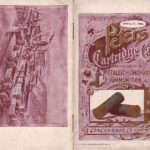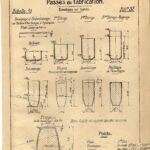Book Review: History of Modern U.S. Military Small Arms Ammunition, Volume III, 1946-1977, By Frank W. Hackley, William H. Woodin & Eugene L. Scranton. Designed and edited by Mel Carpenter.
- November 25, 2023
- 4 Min Read
This book was reviewed by Chris Punnett and originally published in IAA Journal Issue 507, Jan./Feb. 2016
For the last twenty years or so, whenever two cartridge collectors got together, one would inevitably ask – “Any news on Volume 3?” There would be no need to mention the authors’ names or the full title as both knew what they were talking about.
So, almost half a century after Volume I and 37 years after Volume II were published, the third volume of the trilogy has arrived! It is only fair to point out that a Volume I Revised was published in 1998, Volume I Revised Addendum in 2002 and an addendum to Volume II came out in 2009, so the authors have been far from idle. It is with sadness that we report that Gene Scranton passed away in 2013. Understandably, and appropriately, Volume III is dedicated to Gene.
First impression: Wow, it’s big! It’s hardbound, 650 pages, 21 chapters, 4 appendices, 843 illustrations, over 200 box and packaging labels, and an index. Volume III covers the period 1946-1977, picking up the story from Volume II and taking us through to the closure of Frankford Arsenal in 1977.
Nothing encourages military experimentation and development better than war and the influence of the Korean Conflict and the Vietnam War is obvious through the pages of this work. It was a period where established technology was further developed and many new ideas were tested.
The book is divided into four parts. The first two parts (amounting to 290 pages) cover the service calibers for pistol, revolver, carbine, rifle, sub-machine gun and machine gun calibers, from 5.56mm to .60 caliber, and their ongoing development. Part III (150 pages) describes experimental ammunition from micro-calibers to 15mm and 12 gauge and, yes, it contains separate chapters on Project Salvo, SPIW ammunition, 6mm SAW, caseless and expellable ammunition, spotting ammunition and a 60-page chapter on “Other…” which includes micro-calibers, flechettes and taper-bore rounds. Part IV (115 pages) covers miscellaneous ammunition and it is surprising (to me) how many of what we would think of as commercial calibers were made and/or loaded by the military in this period. Part IV includes chapters on 9mm, shot shells, propelling/pyrotechnic/actuating cartridges, and one on things which didn’t fit anywhere else in the book like the rocket-propelled projectiles, underwater cartridges, wound and fragmentation test ammunition and the QSPR rounds. The last chapter deals with unidentified cartridges and components. The four appendices are a list of manufacturers (with a description of how they were involved), tables of standard model numbers, test and experimental model numbers, and Frankford Arsenal test (FAT) numbers.

There was a conscious decision by the authors and the editor to use the same style as that employed in Volumes I and II, so this is not a glossy modern book with lots of color pictures. Illustrations are in black & white with cartridges and components relying on Gene Scranton’s exquisite line drawings. Box and label illustrations are B&W photographs. The text is the same concise prose that we have come to expect from the authors.
There is a fine line between development and experimentation (e.g. a flechette may be a developmental stage in one caliber but an experimental in another) and in some cases the reader will have to rely on the comprehensive index to find what he or she is looking for.
Mel Carpenter has done a fine job designing and editing this immense work, not to mention the amount of time and effort to create that all-important index.
The first two volumes are considered “The Bible” amongst collectors of U.S. small arms ammunition. Volume III will not disappoint. So, was it worth the wait? HELL, YES!
ISBN 978-1-4951-6616-7.
Published by MRC Publishing,
PO Box 665 Orange Park, FL 32067-0665
https://historyofammunition.com/
In addition to his significant role in bringing Volume III to fruition, Mel Carpenter has generously donated and made Volumes I and II of “The History of Modern U.S. Military Small Arms Ammunition” available for free to all members of the International Ammunition Association. These foundational volumes can be accessed through the International Ammunition Association Resource Center, providing an invaluable resource for collectors and enthusiasts. This gesture not only enriches the knowledge base of our community but also honors the legacy of the authors and the rich history of small arms ammunition.






